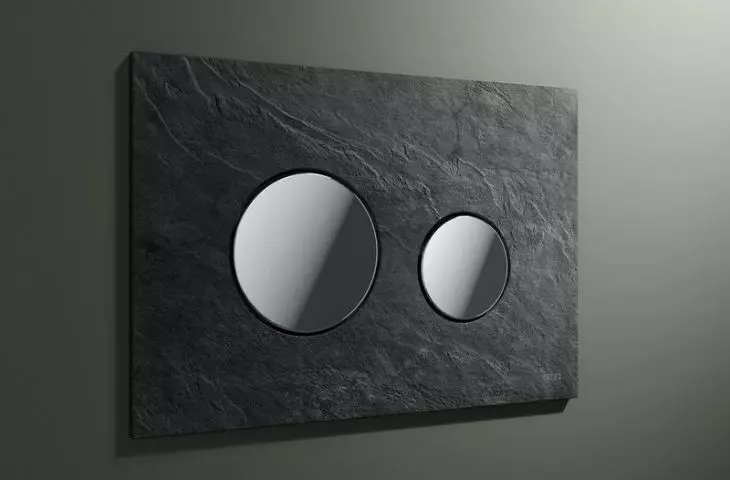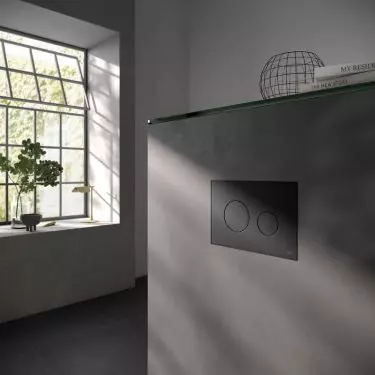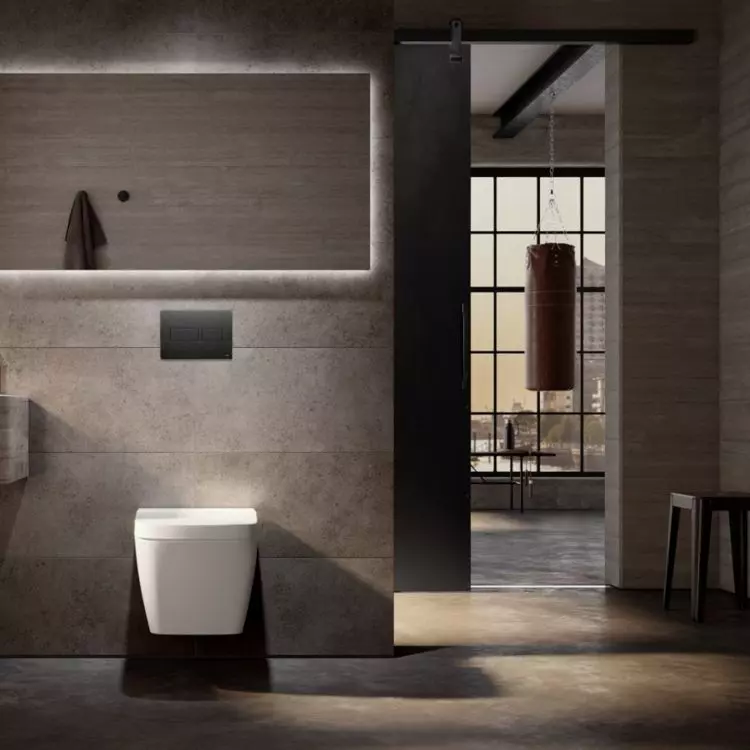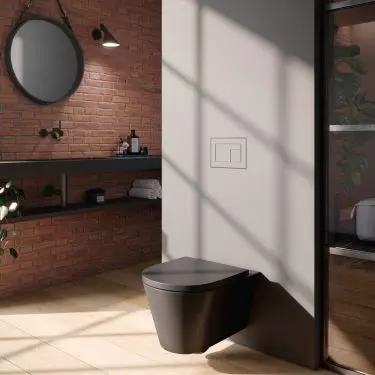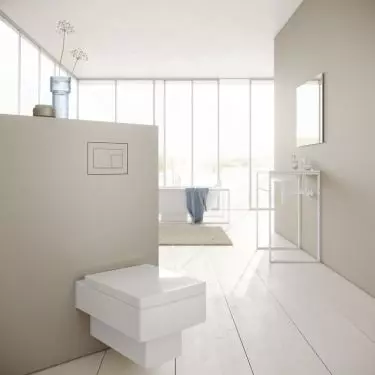Today's bathrooms are full of innovations and technological solutions that are designed not only to make this room more comfortable, but also to introduce economy and ecology into it. One such inconspicuous yet essential element is the flush button, which plays a key role in controlling water consumption in the toilet.
A flush button is a toilet fixture that is used to flush water from the bowl after using the toilet
© TECE
Choosing a flush button
What is a flush button?
A flush button, also known as a toilet button or flush button, is a toilet fixture that is used to flush water from the bowl after using the toilet. This button is usually located on the flush tank, which is placed on the wall or on top of the toilet bowl. The flush button is an important part of bathroom hygiene and water conservation. It allows you to efficiently remove waste from the toilet bowl with minimal water consumption.
Where to buy a flush button?
Choose a flush button from a reputable manufacturer that offers a high-quality range. Buttons from established brands tend to be more durable and less prone to failure. One such company is TECE. It is also worth checking out the offerings of Geberit and OLTENS. A full list of the manufacturers we recommend can be found in the search engine of the Home Products portal under the keyword "flush button".
Types of flush buttons:
Two-button
This type of button usually has two different button sections - one smaller and one larger. By pressing the smaller section, a more economical flush can be made, using less water. By pressing the larger section, a full rinse can be performed, which removes the entire contents of the bowl.
One-button
A single-button flush flushes the toilet in a single flush mode, which is usually tailored to remove more waste. Some toilet models have single-button with a water-saving function, where pressing the button for a short time results in a more economical flush, and a full flush when the button is pressed for a longer time.
There is a choice of single- or double-button
© TECE
How does the flush button work?
The flush button is most often equipped with a mechanism that controls the flow of water from the flush tank to the toilet bowl. The operation of the button depends on the type and design of the flushing system. There are two main methods of operation: overhead tank flush and infrared flush.
Top tank flush
For traditional toilets, the top tank is located on the wall or on top of the toilet bowl. The flush button is connected to a lever or chain, and this is connected to a valve flapper inside the tank. When the button is pressed, water from the tank is released and the valve flapper opens for a period of time, allowing water to pour into the toilet bowl. Flushing can be controlled by the length of time the button is pressed. A short press can trigger an economical flush, while a longer press can trigger a full flush.
Infrared flushing
Modern toilets can be equipped with infrared flushing systems. They use motion or infrared sensors to detect when a user leaves the toilet. When the sensor detects a lack of movement, the toilet automatically triggers a flush, emptying the bowl. This type of flushing is more hygienic because it does not require physically pressing a button. Some modern toilets may also have other advanced features, such as adjusting the amount of water used for flushing. It is worth noting that efficient flushing is important from both a hygiene and environmental perspective, so it is worth choosing toilets and flushing systems that are efficient and environmentally friendly.
What to pay attention to when choosing a flush button?
Compatibility with the toilet model
The most important factor is the compatibility of the button with the toilet model. Different toilets may have different button mounting systems, button hole shapes, and flushing systems. Check your toilet's manual to find out which button is recommended for your model.
Flush type
You should consider whether you want to purchase a two-button or single-button button. A two-button flush helps save water.
Aesthetics
Choose a button that matches the style and design of your bathroom. Flush buttons are available in a variety of designs, shapes and colors to match your overall bathroom decor.
Saving water
If you are concerned about saving water, look out for buttons equipped with a water-saving function. Such buttons can have special markings that tell you how much water will be used when flushing.
Price
The prices of flush buttons can vary, so consider which one fits best into your budget. It's worth investing in a more expensive button that will last longer.
Buttons typically work with overhead tank flush or infrared flush.
© TECE
How to remove a flush button?
Removing a flush button can be a bit tricky, as it depends on the toilet model and flushing system. In general, to remove the flush button, you will need to follow a few steps described below. If you have the opportunity, check your toilet's instruction manual, as different models may have different solutions.
Here is the general way you can try to remove the flush button:
Turn off the water supply
Before you start, make sure the water supply to the toilet is turned off to avoid accidental spills during removal.
Open the flush tank lid
Most toilets have a tank lid that can be removed or lifted. Open the lid to access the inside of the tank.
Locate the flush button
The flush button is located on the flush tank. It is usually attached to the lid or the tank itself.
Check the removability of the button
Depending on the model of the toilet, the button may be screwed on, snapped on or attached in some other way. Check how the button is attached. If the button is screwed on, use a suitable tool, such as a wrench or screwdriver, to unscrew it from the tank. If it is attached by snaps, you may have to gently push or move the button to free it.
Remove the button
Once the button is unscrewed or freed, you can remove it from the tank.
Are flush buttons universal?
Toilet flush buttons are generally not universal, as different toilet models and flushing systems may have different sizes, shapes and button mounting mechanisms. As a result, you can't just take any button and put it on every toilet. Before buying a new flush button, it is worth considering the toilet model, the size and shape of the button, the flushing system, and the brand and model of the button.
Toilet flush buttons are usually not universal, as different toilet models and flushing systems can have different sizes, shapes and button mounting mechanisms
© TECE
How should the float in the cistern be positioned?
The float in the cistern is the component that regulates the water level in the tank and controls when the water stops filling after the toilet is flushed. Proper setting of the float is important to ensure that the cistern works properly and avoids problems with overflowing or leaking water. The float should be set so that the water level in the flush tank is about 1-2 centimeters below the overflow (overflow pipe) by which excess water is directed to the toilet bowl. You can adjust the height of the float to change the water level. It is not recommended to set the float so that the water is at the very level of the overflow, as this can lead to continuous water leakage. Setting the float too low can result in a low water level in the tank, which can lead to inefficient flushing and problems cleaning the bowl. Make sure the float is not set too low. After setting the float, conduct a flush test to make sure the water level is correct. Flush the toilet and observe that the water in the flush tank fills to the correct level and stops filling when that level is reached. Periodically check the condition of the float and adjust it as necessary. The float can become worn or damaged, which can affect its operation.
***
We encourage you to take advantage of the database of reputable and reliable manufacturers of bathroom equipment we are building in the portal Home Products, as well as the articles we publish on bathroom equipment.



